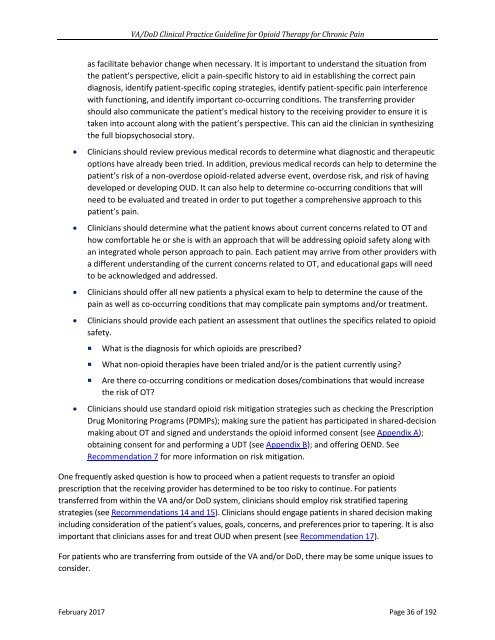VA/DoD CLINICAL PRACTICE GUIDELINE FOR OPIOID THERAPY FOR CHRONIC PAIN
2lfFhbO
2lfFhbO
You also want an ePaper? Increase the reach of your titles
YUMPU automatically turns print PDFs into web optimized ePapers that Google loves.
<strong>VA</strong>/<strong>DoD</strong> Clinical Practice Guideline for Opioid Therapy for Chronic Pain<br />
as facilitate behavior change when necessary. It is important to understand the situation from<br />
the patient’s perspective, elicit a pain-specific history to aid in establishing the correct pain<br />
diagnosis, identify patient-specific coping strategies, identify patient-specific pain interference<br />
with functioning, and identify important co-occurring conditions. The transferring provider<br />
should also communicate the patient’s medical history to the receiving provider to ensure it is<br />
taken into account along with the patient’s perspective. This can aid the clinician in synthesizing<br />
the full biopsychosocial story.<br />
• Clinicians should review previous medical records to determine what diagnostic and therapeutic<br />
options have already been tried. In addition, previous medical records can help to determine the<br />
patient’s risk of a non-overdose opioid-related adverse event, overdose risk, and risk of having<br />
developed or developing OUD. It can also help to determine co-occurring conditions that will<br />
need to be evaluated and treated in order to put together a comprehensive approach to this<br />
patient’s pain.<br />
• Clinicians should determine what the patient knows about current concerns related to OT and<br />
how comfortable he or she is with an approach that will be addressing opioid safety along with<br />
an integrated whole person approach to pain. Each patient may arrive from other providers with<br />
a different understanding of the current concerns related to OT, and educational gaps will need<br />
to be acknowledged and addressed.<br />
• Clinicians should offer all new patients a physical exam to help to determine the cause of the<br />
pain as well as co-occurring conditions that may complicate pain symptoms and/or treatment.<br />
• Clinicians should provide each patient an assessment that outlines the specifics related to opioid<br />
safety.<br />
• What is the diagnosis for which opioids are prescribed?<br />
• What non-opioid therapies have been trialed and/or is the patient currently using?<br />
• Are there co-occurring conditions or medication doses/combinations that would increase<br />
the risk of OT?<br />
• Clinicians should use standard opioid risk mitigation strategies such as checking the Prescription<br />
Drug Monitoring Programs (PDMPs); making sure the patient has participated in shared-decision<br />
making about OT and signed and understands the opioid informed consent (see Appendix A);<br />
obtaining consent for and performing a UDT (see Appendix B); and offering OEND. See<br />
Recommendation 7 for more information on risk mitigation.<br />
One frequently asked question is how to proceed when a patient requests to transfer an opioid<br />
prescription that the receiving provider has determined to be too risky to continue. For patients<br />
transferred from within the <strong>VA</strong> and/or <strong>DoD</strong> system, clinicians should employ risk stratified tapering<br />
strategies (see Recommendations 14 and 15). Clinicians should engage patients in shared decision making<br />
including consideration of the patient’s values, goals, concerns, and preferences prior to tapering. It is also<br />
important that clinicians asses for and treat OUD when present (see Recommendation 17).<br />
For patients who are transferring from outside of the <strong>VA</strong> and/or <strong>DoD</strong>, there may be some unique issues to<br />
consider.<br />
February 2017 Page 36 of 192


